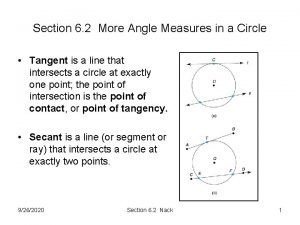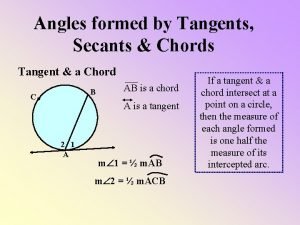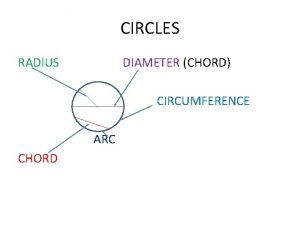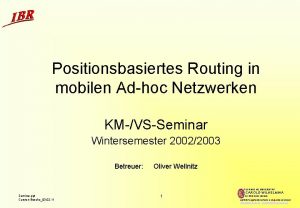Effizientes Routing in P 2 P Netzwerken Chord




















- Slides: 20

Effizientes Routing in P 2 P Netzwerken Chord: A Scalable Peer-topeer Lookup Protocol for Internet Applications Dennis Schade

Outline Short introduction to P 2 P systems n Chord System Model n Chord Algorithm n Simulation Results n Future Work n

Introduction to P 2 P Systems Basic principles n sharing ressources n decentralization n self-organization Main problems n load balancing n decentralization ¨ ¨ n Main advantages n no Single Point of Failure n load balancing n scalability n self-organization availability scalability efficient node localization

Addressing data Data addressed by a Hashtable n calculating hashvalues for keys n storing reference to data identified by hashvalues In P 2 P systems the hashtable is n partitioned n distributed over peers Such a hashtable is called distributed hashtable (DHT)

Chord: A Scalable Peer-to-peer Lookup Protocol Efficient node localization n Distributed lookup protocol n Only one operation: given a key, Chord maps the key onto a node n Simplicity, provable performance, proven correctness n

The Chord System Model n n Every node has an unique identifier Identifiers are arranged on a identifier circle modulo 2 m m is called exponent of the ring Nodes know their successor and predecessor

The Chord System Model n key k is assigned to the node whose identifier is equal to or greater than k this node is called successor(k) ¨ it is the first node clockwise from k. ¨ lookup(k) returns responsible peer ¨

The Chord algorithm Simple node localization // ask node n to find the successor of id n. lookup(id) if (id (n; successor]) return successor; else // forward query around the circle return successor. lookup(id); Number of messages linear in number of nodes

The Chord algorithm – Scalable node localization n Each node holds additional routing information to accelerate lookups ¨ nodes have a so called finger table with up to m entries ¨ ith finger table entry at node x points to the first node y that succeds x‘s ID by at least 2 i-1 ¨ y = lookup(x. ID + 2 i-1)

Example: Scalable node localization Finger table for N 8 (m=6) N 8+1 K 9 N 14 N 8+2 K 10 N 14 N 8+4 K 12 N 14 N 8+8 K 16 N 21 N 8+16 K 24 N 32 N 8+32 K 40 N 42 finger[i] = lookup(x. ID + 2 i-1)

The Chord algorithm – Scalable node localization n n search in finger table for the node n which most immediatly precedes key k n. lookup(k) Number of messages: O(log N)

The Chord algorithm – Node joins and stabilization ? (1) (2) (3)

The Chord algorithm – Node joins and stabilization Stabilization protocol for a node x: n x. stabilize(): ask successor y for its predecessor p ¨ if p (x; y] then p is x‘s new successor ¨ n x. notify(): notify x‘s successor p of x‘s existence ¨ notified node may change predecessor to x ¨

The Chord algorithm – Node joins and stabilization (1) (2) (3)

Implementation Overview stabilizer server fingertable Mediator ftableupdate lookup clients N 56

Implementation Demonstration

Simulation & test results Test conditions n fully populated chord ring of size 8, 16 and 32 n correct fingertables n no node joins n no node departure n communication over loopback device

Simulation & test results Test results n number of forwardings in O(log N) n bandwidth usage (TCP) ≤ 1 KB/s n bandwidth usage (UDP) ≤ 2. 5 KB/s n average lookup time is ≤ 50 ms

Future work n Impact on lookups random node joins and departures ¨ incorrect finger tables ¨ improvements in communication protocol n support of node distances n S-Chord n

Questions & Discussion Thank you for attention! Questions?
 Effizientes portfolio
Effizientes portfolio Selbstdarstellung in sozialen netzwerken
Selbstdarstellung in sozialen netzwerken Special segments in a circle
Special segments in a circle Nada gis enharmonis dengan nada
Nada gis enharmonis dengan nada Segment relationships in circles
Segment relationships in circles Continuity equation hydrology
Continuity equation hydrology Clock and power routing in vlsi
Clock and power routing in vlsi Goodrich method flood routing
Goodrich method flood routing Static routing and dynamic routing
Static routing and dynamic routing Vocal chord singingflat singing
Vocal chord singingflat singing Madrigal proper
Madrigal proper Chord geometry
Chord geometry Angles formed by secants and tangents
Angles formed by secants and tangents Tangent secant power theorem
Tangent secant power theorem Secant tangent
Secant tangent Christian naylor
Christian naylor Tension member in a steel truss
Tension member in a steel truss Circle area
Circle area Euclidean geometry grade 11
Euclidean geometry grade 11 Richard wagner romantic era
Richard wagner romantic era Tangent radius theorem
Tangent radius theorem






































